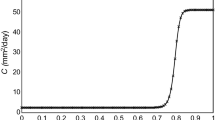Abstract
The time dependent behaviour of composite prestressed concrete beams depends upon the presence of differential shrinkage and creep of the concretes of web and deck, in addition to other parameters, such as relaxation of steel, presence of untensioned steel, and compression steel etc.
In view of the interrelationships among these various parameters, it is proposed to isolate the effects of differential shrinkage and creep from other parameters by studying the behaviour of composite prisms under sustained load.
The stresses and strains in composite prisms made up of two different concretes under sustained load are analytically determined using varying stiffness method of analysis. Creep and shrinkage characteristics of the two concretes are obtained from preliminary experiments using C.E.B. and also A.C.I. recommendations. The analytical results are found to be in close agreement with the experimental values obtained on three concrete prisms under sustained load for 160 days and thus also confirm the method of analysis.
Résumé
Le comportement dans le temps des poutres de béton précontraint composite dépend du retrait différentiel et du fluage des bétons de l'âme et du tablier, sans compter d'autres paramètres, tels que la relaxation de l'acier, la présence d'acier non tendu et d'acier de compression etc. Cette étude a séparé les effets du retrait différential et du fluage de ceux des autres paramètres qui leur sont associés, au moyen d'un essai de charge de longue durée sur un prisme de béton composite, et l'on décrit aussi une méthode d'analyse dite «méthode de rigidité variable» pour en prédire le comportement: Les contraintes et déformations du prisme composite constitué de deux bétons différents et soumis à une charge de longue durée sont déterminées analytiquement. Les caractéristiques de fluage et de retrait des deux bétons sont fournies par des expériences préliminaires selon les recommandations du C.E.B. et de l'A.C.I. Les résultats analytiques concordent bien avec les valeurs expérimentales obtenues sur trois prismes de béton chargés durant 160 jours ce qui corrobore également la méthode analytique utilisée.
Similar content being viewed by others
Abbreviations
- A :
-
area of section
- E :
-
modulus of elasticity
- P :
-
external force
- ΔP S (k) :
-
change of axial force in interval “k”
- K b,K c,K d,K e andK t :
-
partial coefficients of creep or shrinkage
- T(k) :
-
age of concrete in interval “k”
- ε:
-
general strain
- ΔP s (i) :
-
change of force in interval “i”
- Δεs(k):
-
change of strain in interval “k” due to forces acting in that interval
- εt(k):
-
total strain at the end of interval “k”
- ΔσS(k):
-
change of stress in concrete due to change of forces developed in the interval
- Φ(k, i):
-
creep coefficient at the ageT e (k) due to force applied at ageT m (k)
- Δ:
-
prefix to indicate a change in the quantity that follows
- 1:
-
properties relating to the rich concrete of the composite prism
- 2:
-
properties relating to the lean concrete of the composite prism
- e :
-
end of interval
- m :
-
middle of the interval
- v :
-
varying property of intervalk
- DC :
-
due to differential creep
- DS :
-
due to differential shrinkage
- SH :
-
due to shrinkage
- P :
-
change of strain during an interval due to creep effects of previous forces acting up to the beginning of the interval
- f c :
-
stress in concrete
References
Birkeland H. W.—Differential shrinkage in composite beams. Journal of American Concrete Institute, May 1960, pp. 1123–1136.
Branson D. E., Ozell A. M., Miller A. I. et al.—Discussion of a paper by Halvard W. Birkeland. Journal of American Concrete Institute, December 1960, pp. 1529–1558.
Rao V. J., Dilger W.—Time dependent behaviour of composite prestressed concrete beams. University of Calgary, Calgary, Alberta, Canada, 1973.
Jagannadha Rao V., Dilger W. H.—Time dependent deflections of composite prestressed concrete beams. Publication SP-43 American Concrete Institute, pp. 421–442.
International recommendations for the design and construction of concrete structures. Principles and recommendations, June 1970: FIP Sixth Congress Prague, pp. 27–29.
A.C.I. Committee 209 Sub-committee Chairman Dan E. Branson:Prediction of creep, shrinkage and temperature effects in concrete structures. Publication SP-27 American Concrete Institute, pp. 56–58.
Notes on ACI 318-71:Building code requirements with design applications. Part 6: Serviceability requirements, control of Deflection, pp. 6–7.
Author information
Authors and Affiliations
Rights and permissions
About this article
Cite this article
Jagannadha Rao, V., Venkateswarlu, T. Role of differential shrinkage and creep in time dependent behaviour of composite members. Mat. Constr. 10, 79–84 (1977). https://doi.org/10.1007/BF02474855
Issue Date:
DOI: https://doi.org/10.1007/BF02474855




